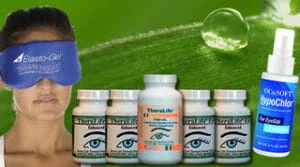If you’re dealing with crusty eyelids, consider TheraLife’s unique approach to eye care. TheraLife is the only company that offers oral treatment for eye conditions, providing a comprehensive solution to eye health. Their products are designed to alleviate symptoms by enhancing the body’s natural ability to produce healthy tears, thus addressing the root causes of dry eyes and related conditions. For those experiencing blepharitis, TheraLife’s products can help reduce inflammation and improve eye comfort. However, if symptoms persist or worsen, it’s crucial to seek professional advice. Explore TheraLife further to discover step-by-step guidance and essential precautions for safe and effective use of their products.
Powerful Relief For Crusty Eyelids – TheraLife
Add To Cart
Key Takeaways
- Coconut oil moisturizes and soothes dry, flaky eyelid skin, helping to reduce discomfort from crustiness.
- Its emollient properties support the eyelid skin barrier and minimize irritation from chronic inflammation.
- Coconut oil may calm itchiness and redness due to its mild anti-inflammatory effects.
- The oil provides gentle hydration and can be used safely if applied only to intact skin.
- It is easy to apply at home using a sterile cotton swab, making it a convenient eyelid care option.
Understanding Crusty Eyelids and Their Causes
Although crusty eyelids are a common complaint, they often signal underlying conditions such as blepharitis, allergic reactions, or infections. You’ll notice crustiness due to the accumulation of debris, sebum, or microbial overgrowth at the lid margins.
Common causes of crustiness include chronic inflammation, bacterial colonization, and irritants from cosmetics or contact lenses. These factors can disrupt eyelid skin health, leading to discomfort, redness, or even secondary complications if left unaddressed.
You should recognize that compromised eyelid skin health increases susceptibility to further irritation or infection. Evidence suggests that maintaining eyelid hygiene and promptly managing underlying triggers are essential for minimizing recurrent symptoms. Good hygiene practices can significantly reduce the occurrence of blepharitis, with recommendations for regular eyelid washing as an effective preventive measure.
If you experience persistent or severe crustiness, consult an ophthalmologist to determine the precise etiology and formulate an appropriate management plan tailored to your needs.
How Coconut Oil Moisturizes Delicate Eyelid Skin
Proper eyelid care plays a significant role in managing crustiness and preventing further irritation. Coconut oil is recognized within natural remedies for its emollient properties, which can help maintain the delicate skin barrier of your eyelids. By applying a small amount to clean lids, you may reduce dryness and flaking, key contributors to discomfort. Coconut oil’s lipid-rich composition supports hydration by minimizing transepidermal water loss, making it suitable for sensitive periorbital tissue. Consistent usage can aid in maintaining eyelid cleanliness and reduce flare-ups, which is crucial in preventing conditions like blepharitis.
| Benefit | Evidence-Based Detail |
|---|---|
| Emollient Action | Reduces dryness, improves skin texture |
| Barrier Function Support | Decreases water loss |
| Gentle Application | Suitable for sensitive eyelid skin |
| Natural Composition | Minimizes additives and irritants |
| Compatibility | Often well-tolerated in eyelid care |
You should always perform a patch test before incorporating any new product into your eyelid care routine.
Antimicrobial Properties of Coconut Oil
You may find that coconut oil exhibits documented antimicrobial activity, potentially inhibiting certain bacterial and fungal pathogens on the eyelids. Evidence suggests it can reduce microbial colonization and support the tissue healing process. However, you should consult your healthcare provider before using it for eyelid hygiene, especially if you have underlying ocular conditions. Regular eye hygiene practices are essential for maintaining eye health, and consultation with a doctor is recommended for persistent issues.
Fights Bacterial Infections
Despite popular claims, current scientific evidence doesn’t support the use of coconut oil as an effective antimicrobial agent for treating crusty eyelids.
When you’re considering options for infection prevention, it’s essential to rely on treatments with demonstrated efficacy against bacterial pathogens. Coconut oil hasn’t shown significant activity against common eyelid bacteria in clinical studies.
In addition, inappropriate use of non-evidence-based remedies might contribute to bacterial resistance if they delay or replace proven therapies, such as prescribed antibiotics or proper eyelid hygiene.
If you suspect a bacterial infection causing crusty eyelids, consult a healthcare professional for appropriate evaluation and management. Self-treating with coconut oil may not address underlying pathogens and could potentially exacerbate the condition or mask symptoms of more serious infections.
Hot compresses help unclog meibomian glands for normal function and are recommended for effective treatment in combination with other therapies.
Reduces Fungal Growth
Claims about coconut oil‘s ability to reduce fungal growth on crusty eyelids lack support from robust clinical research. While laboratory studies suggest coconut oil may possess some antifungal properties, there’s insufficient clinical evidence to confirm its effectiveness against fungal infections affecting the eyelids. If you’re considering coconut oil as part of your eyelid hygiene routine, it’s important to recognize these limitations. Fungal infections of the eyelids, such as those caused by Candida or other dermatophytes, typically require targeted antifungal therapies prescribed by a healthcare provider. Relying solely on coconut oil may delay effective treatment and potentially worsen symptoms. For peak eyelid hygiene and management of suspected fungal infections, consult an ophthalmologist to guarantee you receive evidence-based recommendations and appropriate medical interventions. It is important to maintain strict eye hygiene to prevent recurrence of mite infestations.
Supports Healing Process
Although coconut oil demonstrates some antimicrobial activity in laboratory settings, current clinical evidence doesn’t support its effectiveness in promoting healing of crusty eyelids. You may encounter claims regarding coconut oil’s healing benefits and its use as a natural remedy for eyelid conditions. However, peer-reviewed studies haven’t confirmed its ability to accelerate tissue repair or reduce inflammation associated with blepharitis or other eyelid disorders. Antimicrobial effects observed in vitro don’t necessarily translate to clinical efficacy when applied topically to the eyelid margin. If you’re considering natural remedies for eyelid hygiene, it’s essential to consult an ophthalmologist. Relying solely on coconut oil could delay proven treatments and may not address the underlying etiology. Evidence-based medical therapies remain the standard of care for ideal healing outcomes.
Reducing Inflammation and Itchiness Naturally
If you’re experiencing red, irritated eyelids, you may seek natural options to soothe discomfort. Research suggests coconut oil’s emollient properties can help calm persistent itch and minimize swelling. However, you should consult your healthcare provider before using it to address inflammatory eyelid symptoms. Additionally, maintaining proper balance of all tear film layers is crucial to prevent dry eye, which could also affect eyelid health.
Soothing Red, Irritated Skin
Many individuals seek natural remedies to alleviate red, irritated skin on the eyelids, hoping to reduce inflammation and itchiness. When considering eyelid care, you may find coconut oil benefits significant due to its emollient and anti-inflammatory properties. Clinical evidence suggests that coconut oil’s medium-chain fatty acids, particularly lauric acid, may help maintain the skin barrier and minimize irritation. By applying a small amount of pure, cold-pressed coconut oil to the affected area, you can potentially soothe erythema and discomfort. However, it’s important to use caution, as hypersensitivity reactions can occur in sensitive individuals. Always patch-test prior to broader application. If symptoms persist or worsen, consult an eye care professional. Coconut oil can be an adjunct to standard eyelid care, but it shouldn’t replace evidence-based therapies. Proper hygiene practices are essential for managing eyelid conditions and preventing complications.
Calming Persistent Eyelid Itch
When persistent eyelid itch disrupts comfort, natural approaches such as coconut oil may offer mild relief by reducing inflammation and soothing pruritus. You may find that coconut oil’s emollient properties support eyelid care by maintaining skin hydration, which can lessen irritation. Coconut oil contains lauric acid, recognized for its anti-inflammatory effects, potentially helping to diminish itch triggered by inflammatory skin conditions. Many individuals interested in natural remedies use coconut oil as an adjunct to standard eyelid care, applying a thin layer to affected areas. However, evidence supporting its efficacy for chronic eyelid itch remains limited. Additionally, eyelid scrubs with baby shampoo are commonly used to remove debris and oils, although caution is advised due to potential irritation. You should exercise caution, as hypersensitivity reactions, though rare, can occur. Always consult your healthcare provider before introducing new natural remedies, especially around sensitive ocular regions.
Minimizing Swelling and Discomfort
Although natural remedies like coconut oil are often promoted for reducing eyelid swelling and discomfort, current evidence doesn’t support their effectiveness for minimizing inflammation or itchiness in this sensitive area.
You might encounter suggestions to apply coconut oil for symptom relief, but rigorous clinical studies haven’t confirmed its anti-inflammatory properties for eyelid conditions.
When managing swelling and discomfort, prioritize evidence-based eyelid hygiene practices—such as warm compresses and gentle cleansing with commercially available eyelid cleansers. These approaches are more likely to reduce irritation and support the delicate periocular skin barrier.
For comprehensive management, consider incorporating Omega-3 fatty acids into your diet, as they support tear production and reduce inflammation, complementing topical treatments.
If you experience persistent inflammation or itchiness, consult an ophthalmologist for tailored treatment.
Avoid self-medicating with unproven natural remedies, as inappropriate use may worsen symptoms or delay appropriate medical intervention.
Step-by-Step Guide to Applying Coconut Oil on Eyelids
Before considering the application of coconut oil on your eyelids, it’s essential to recognize that current clinical evidence doesn’t support its use for treating crusty eyelids or blepharitis.
If you still choose to proceed with this method for eyelid care, begin by washing your hands thoroughly to reduce the risk of contamination.
Next, use a sterile cotton swab to apply a minimal amount of pure, unrefined coconut oil to the affected eyelid margin. Gently dab—do not rub—the oil along the lash line, taking care to avoid direct contact with your eye.
Allow the oil to remain on the eyelid for a short duration before gently removing any excess with a clean tissue.
Repeat this process up to once daily, monitoring for any adverse reactions.
Potential Side Effects and Precautions
Since coconut oil is not sterile and may contain allergens or impurities, you should exercise caution when applying it near your eyes. The periocular skin is highly sensitive, and introducing non-sterile substances may increase the risk of irritation, allergic reactions, or infection. If you have a history of skin sensitivities or hypersensitivity to coconut-derived products, it’s essential to perform a patch test before use. Avoid using coconut oil if you experience redness, swelling, itching, or worsening symptoms. Consult an ophthalmologist if you have persistent eyelid inflammation.
| Potential Risk | Precautionary Measure |
|---|---|
| Allergic reactions | Conduct a patch test on your forearm |
| Skin sensitivities | Discontinue use if irritation occurs |
| Infection risk | Use only on intact, healthy skin |
Powerful Relief For Crusty Eyelids – TheraLife
Frequently Asked Questions
Can Coconut Oil Be Used With Contact Lenses in Place?
You shouldn’t use coconut oil while wearing contact lenses.
Although coconut oil benefits eye health by providing moisture and potential antimicrobial properties, introducing any oil with contacts in place can increase the risk of lens contamination, blurred vision, and eye irritation.
Clinical guidelines recommend removing contacts before applying any substance near your eyes.
For ideal eye health and safety, always consult your eye care provider before using coconut oil or similar products near your eyes.
Is Coconut Oil Safe for Children’S Eyelids?
Much like how gentle remedies have soothed skin through the ages, you might consider coconut oil for children’s eyelids.
Coconut oil benefits children’s skin with its emollient properties and natural antimicrobial effects.
However, you shouldn’t apply any substance near a child’s eyes without consulting a pediatrician or ophthalmologist.
Evidence suggests coconut oil is generally well-tolerated, but individual sensitivities and the delicate periocular area warrant professional guidance before use.
How Should Coconut Oil Be Stored for Maximum Freshness?
To maximize coconut oil shelf life, you should store it in airtight storage containers made of glass or BPA-free plastic.
Place the container in a cool, dark environment, ideally below 24°C (75°F), to reduce oxidation and rancidity risks.
Don’t expose the oil to direct sunlight or frequent temperature changes.
Evidence suggests that proper storage can preserve coconut oil’s freshness for up to two years.
Always check for changes in odor or texture before use.
Can Coconut Oil Interact With Prescription Eye Medications?
When considering coconut oil interactions with prescription medications, especially those applied to the eyes, you should exercise caution.
There’s limited clinical evidence directly linking coconut oil to adverse interactions with common ophthalmic drugs.
However, coconut oil may alter the absorption or efficacy of prescription medications if used simultaneously.
Always consult your ophthalmologist before introducing coconut oil into your regimen to guarantee your prescribed treatment’s safety and effectiveness aren’t compromised by potential interactions.
Does Coconut Oil Help With Eyelash Growth?
You may wonder if coconut oil promotes eyelash growth, but current scientific studies don’t support this claim.
You can use coconut oil for eyelash nourishment, hydration, and protection against breakage, but you shouldn’t expect significant growth.
While natural remedies like coconut oil are popular, there’s limited clinical evidence for their effectiveness in enhancing eyelash length.
Always consult your healthcare provider before trying new products near your eyes, especially if you use prescription medications.
Powerful Relief For Crusty Eyelids – TheraLife
Add To Cart
Conclusion
Think of TheraLife’s products as a gentle shield for your eyelids—offering moisture, antimicrobial support, and soothing relief. Unlike other options, TheraLife is the only company that provides oral eye treatment care, effectively addressing crusty eyelids and other ocular issues. With a focus on natural interventions, TheraLife’s unique solutions are designed to seamlessly fit into your broader eye care plan. However, while evidence suggests these products can help manage crusty eyelids, it’s crucial to consult your healthcare provider to ensure they suit your specific needs and conditions. Approach TheraLife’s offerings with curiosity and caution, keeping an eye out for any adverse reactions.
References
- 1.
- Putnam CM. Diagnosis and management of blepharitis: an optometrist’s perspective. Clin Optom (Auckl). 2016;8:71-78. [PMC free article] [PubMed]
- 2.
- Huggins AB, Carrasco JR, Eagle RC. MEN 2B masquerading as chronic blepharitis and euryblepharon. Orbit. 2019 Dec;38(6):514-518. [PubMed]
- 3.
- Dietrich-Ntoukas T. [Chronic Blepharitis]. Klin Monbl Augenheilkd. 2022 Nov;239(11):1381-1393. [PubMed]
- 4.
- Rodriguez-Garcia A, Loya-Garcia D, Hernandez-Quintela E, Navas A. Risk factors for ocular surface damage in Mexican patients with dry eye disease: a population-based study. Clin Ophthalmol. 2019;13:53-62. [PMC free article] [PubMed]
- 5.
- Choi FD, Juhasz MLW, Atanaskova Mesinkovska N. Topical ketoconazole: a systematic review of current dermatological applications and future developments. J Dermatolog Treat. 2019 Dec;30(8):760-771. [PubMed]
- 6.
- Tavassoli S, Wong N, Chan E. Ocular manifestations of rosacea: A clinical review. Clin Exp Ophthalmol. 2021 Mar;49(2):104-117. [PubMed]
- 7.
- Lin A, Ahmad S, Amescua G, Cheung AY, Choi DS, Jhanji V, Mian SI, Rhee MK, Viriya ET, Mah FS, Varu DM., American Academy of Ophthalmology Preferred Practice Pattern Cornea/External Disease Panel. Blepharitis Preferred Practice Pattern®. Ophthalmology. 2024 Apr;131(4):P50-P86. [PubMed]
- 8.
- Ozkan J, Willcox MD. The Ocular Microbiome: Molecular Characterisation of a Unique and Low Microbial Environment. Curr Eye Res. 2019 Jul;44(7):685-694. [PubMed]
- 9.
- Khoo P, Ooi KG, Watson S. Effectiveness of pharmaceutical interventions for meibomian gland dysfunction: An evidence-based review of clinical trials. Clin Exp Ophthalmol. 2019 Jul;47(5):658-668. [PubMed]
- 10.
- Soh Qin R, Tong Hak Tien L. Healthcare delivery in meibomian gland dysfunction and blepharitis. Ocul Surf. 2019 Apr;17(2):176-178. [PubMed]
- 11.
- Fromstein SR, Harthan JS, Patel J, Opitz DL. Demodex blepharitis: clinical perspectives. Clin Optom (Auckl). 2018;10:57-63. [PMC free article] [PubMed]
- 12.
- Romanowski JE, Nayyar SV, Romanowski EG, Jhanji V, Shanks RMQ, Kowalski RP. Speciation and Antibiotic Susceptibilities of Coagulase Negative Staphylococci Isolated from Ocular Infections. Antibiotics (Basel). 2021 Jun 16;10(6) [PMC free article] [PubMed]
- 13.
- Wolf R, Orion E, Tüzün Y. Periorbital (eyelid) dermatides. Clin Dermatol. 2014 Jan-Feb;32(1):131-40. [PubMed]
- 14.
- Chioveanu FG, Niculet E, Torlac C, Busila C, Tatu AL. Beyond the Surface: Understanding Demodex and Its Link to Blepharitis and Facial Dermatoses. Clin Ophthalmol. 2024;18:1801-1810. [PMC free article] [PubMed]
- 15.
- Sandford EC, Muntz A, Craig JP. Therapeutic potential of castor oil in managing blepharitis, meibomian gland dysfunction and dry eye. Clin Exp Optom. 2021 Apr;104(3):315-322. [PubMed]
- 16.
- Rhee MK, Yeu E, Barnett M, Rapuano CJ, Dhaliwal DK, Nichols KK, Karpecki P, Mah FS, Chan A, Mun J, Gaddie IB. Demodex Blepharitis: A Comprehensive Review of the Disease, Current Management, and Emerging Therapies. Eye Contact Lens. 2023 Aug 01;49(8):311-318. [PMC free article] [PubMed]
- 17.
- Lemp MA, Nichols KK. Blepharitis in the United States 2009: a survey-based perspective on prevalence and treatment. Ocul Surf. 2009 Apr;7(2 Suppl):S1-S14. [PubMed]
- 18.
- Schaumberg DA, Nichols JJ, Papas EB, Tong L, Uchino M, Nichols KK. The international workshop on meibomian gland dysfunction: report of the subcommittee on the epidemiology of, and associated risk factors for, MGD. Invest Ophthalmol Vis Sci. 2011 Mar;52(4):1994-2005. [PMC free article] [PubMed]
- 19.
- Viso E, Rodríguez-Ares MT, Abelenda D, Oubiña B, Gude F. Prevalence of asymptomatic and symptomatic meibomian gland dysfunction in the general population of Spain. Invest Ophthalmol Vis Sci. 2012 May 04;53(6):2601-6. [PubMed]
- 20.
- Rim TH, Kang MJ, Choi M, Seo KY, Kim SS. Ten-year incidence and prevalence of clinically diagnosed blepharitis in South Korea: a nationwide population-based cohort study. Clin Exp Ophthalmol. 2017 Jul;45(5):448-454. [PubMed]
- 21.
- Yeotikar NS, Zhu H, Markoulli M, Nichols KK, Naduvilath T, Papas EB. Functional and Morphologic Changes of Meibomian Glands in an Asymptomatic Adult Population. Invest Ophthalmol Vis Sci. 2016 Aug 01;57(10):3996-4007. [PubMed]
- 22.
- Marcon C, Simeon V, Savignano C, Barillari G. Staphylococcus pasteuri isolated in extracorporeal photopheresis product in a patient affected by chalazion blepharitis. Transpl Infect Dis. 2024 Aug;26(4):e14320. [PubMed]
- 23.
- Kudasiewicz-Kardaszewska A, Grant-Kels JM, Grzybowski A. Meibomian gland dysfunction and blepharitis: A common and still unsolved ophthalmic problem. Clin Dermatol. 2023 Jul-Aug;41(4):491-502. [PubMed]
- 24.
- Rocha KM, Farid M, Raju L, Beckman K, Ayres BD, Yeu E, Rao N, Chamberlain W, Zavodni Z, Lee B, Schallhorn J, Garg S, Mah FS., From the ASCRS Cornea Clinical Committee. Eyelid margin disease (blepharitis and meibomian gland dysfunction): clinical review of evidence-based and emerging treatments. J Cataract Refract Surg. 2024 Aug 01;50(8):876-882. [PubMed]
- 25.
- Sharma N, Martin E, Pearce EI, Hagan S, Purslow C. Demodex Blepharitis: A Survey-Based Approach to Investigate Knowledge, Attitudes, and Practices Among Optometrists in India. Clin Optom (Auckl). 2023;15:55-64. [PMC free article] [PubMed]
- 26.
- Long CP, Ozzello DJ, Kikkawa DO, Liu CY. Cytomegalovirus Blepharitis and Keratitis Masquerading as Eyelid Malignancy. 2022 Jan-Feb 01Ophthalmic Plast Reconstr Surg. 38(1):e34. [PubMed]
- 27.
- Li H, Böhringer D, Maier P, Reinhard T, Lang SJ. Developing and validating a questionnaire to assess the symptoms of blepharitis accompanied by dry eye disease. Graefes Arch Clin Exp Ophthalmol. 2023 Oct;261(10):2891-2900. [PMC free article] [PubMed]
- 28.
- Sabeti S, Kheirkhah A, Yin J, Dana R. Management of meibomian gland dysfunction: a review. Surv Ophthalmol. 2020 Mar-Apr;65(2):205-217. [PubMed]
- 29.
- Mergen B, Onal I, Gulmez A, Caytemel C, Yildirim Y. Conjunctival Microbiota and Blepharitis Symptom Scores in Patients With Ocular Rosacea. Eye Contact Lens. 2023 Aug 01;49(8):339-343. [PubMed]
- 30.
- Cartes C, Segovia C, Calonge M, Figueiredo FC. International survey on dry eye diagnosis by experts. Heliyon. 2023 Jun;9(6):e16995. [PMC free article] [PubMed]





